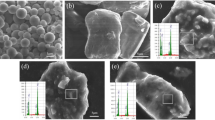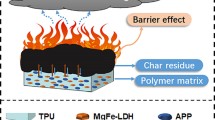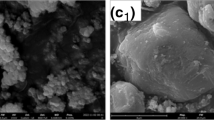Abstract
To demonstrate the influence of core-shell structure of microencapsulated ammonium polyphosphate (MCAPPs) on the flame-resistant and smoke inhibition efficiency of polymer composites, four kinds of MCAPPs with unilaminar or bistratal shells were fabricated and used to fabricate flame retarded Poly (butyleneadipate-co-terephthalate) (PBAT) composites. The MCAPP with cross-linked β-cyclodextrin as outer layer (MFAPP-CD1) exhibited the highest flame-resistant efficiency. Accordingly, 75P/25MFAPP-CD1 showed the highest char residue and densest char layer, also the lowest pHRR and THR, decreasing by 77.4 and 76.9% compared with PBAT, respectively. Meanwhile, the lowest SPR and TSP also demonstrated its excellent smoke inhibition effect due to the weakened catalytic effect of Ammonium polyphosphate (APP) on carbonization agent. As a result, a LOI value (33.2%) and UL-94 V0 rating could be achieved. A reasonable core-shell structure could improve the carbon forming capacity and reduce the release of volatiles during combustion. Polyhydroxy carbonization agent should be designed as the outer layer of bistratal MCAPP.
Graphical Abstract














Similar content being viewed by others
References
Chen W, Liu P, Liu Y, Liu Z (2022) Recent advances in two-dimensional Ti3C2Tx MXene for flame retardant polymer materials. Chem Eng J. https://doi.org/10.1016/j.cej.2022.137239
Jian J, Zeng X, Huang X (2020) An overview on synthesis, properties and applications of poly (butylene-adipate-co-terephthalate)–PBAT. Adv Industrial Eng Polym Res 3(1):19–26. https://doi.org/10.1016/j.aiepr.2020.01.001
Liu B, Zhao H, Wang Y (2021) Advanced flame-retardant methods for polymeric materials. Adv Mater. https://doi.org/10.1002/adma.202107905
Shi X, Li X, Li Y, Li Z, Wang D (2022) Flame-retardant strategy and mechanism of fiber reinforced polymeric composite: a review. Compos B. https://doi.org/10.1016/j.compositesb.2022.109663
Shen Y, Gong W, Zheng B, Meng X, Gao L (2016) Synergistic effect of Ni-based bimetallic catalyst with intumescent flame retardant on flame retardancy and thermal stability of polypropylene. Polym Degrad Stab 129:114–124. https://doi.org/10.1016/j.polymdegradstab.2016.04.006
Kundu C, Li Z, Song L, Hu Y (2020) An overview of fire retardant treatments for synthetic textiles: from traditional approaches to recent applications. Eur Polym J 137:109911. https://doi.org/10.1016/j.eurpolymj.2020.109911
She T, Zhang S, Shi X (2021) Oxidized regenerated celluloses to fabricate high fire safety for epoxy resin with super expansion char layer. Cellulose 28(5):2995–3015. https://doi.org/10.1007/s10570-021-03723-y
Du H, Ren J, Fu X, Zhang W, Yang R (2022) Simultaneous improvements of the fire safety, mechanical properties and water resistance of vinyl ester resin composites by introducing microencapsulated ammonium polyphosphate by polytriazole. Compos B 238:109908. https://doi.org/10.1016/j.compositesb.2022.109908
Zhao X, Chen L, Li D, Feng T, He L, Wang X, Wang Y (2021) Biomimetic construction peanut-leaf structure on ammonium polyphosphate surface: improving its compatibility with poly (lactic acid) and flame-retardant efficiency simultaneously. Chem Eng J 412:128737. https://doi.org/10.1016/j.cej.2021.128737
Tang G, Jiang H, Yang Y, Chen D, Liu C, Zhang P, Zhou L, Huang X, Zhang H, Liu X (2020) Preparation of melamine–formaldehyde resin-microencapsulated ammonium polyphosphate and its application in flame retardant rigid polyurethane foam composites. J Polym Res 27(12):1–14. https://doi.org/10.1007/s10965-020-02343-7
Zhang B, Jiang Y, Han J (2017) The core-double-shell microcapsules flame retardant: synthesis and its application for polyvinyl chloride composites. J Phys Chem Solids 111:391–402. https://doi.org/10.1016/j.jpcs.2017.08.037
Zhao K, Xu W, Song L, Wang B, Feng H, Hu Y (2012) Synergistic effects between boron phosphate and microencapsulated ammonium polyphosphate in flame-retardant thermoplastic polyurethane composites. Polym Advan Technol 23(5):894–900. https://doi.org/10.1002/pat.1985
Decsov K, Bocz K, Szolnoki B, Bourbigot S, Fontaine G, Vadas D, Marosi G (2019) Development of bioepoxy resin microencapsulated ammonium-polyphosphate for flame retardancy of polylactic acid. Molecule 24(22):4123. https://doi.org/10.3390/molecules24224123
Yang Y, Chen W, Liu M, Zhu Q, Liu X, Zhang B, Chen D, Liu X, Zhang K, Tang G (2021) Flame retarded rigid polyurethane foam composites based on gel-silica microencapsulated ammonium polyphosphate. J Sol-Gel Sci Technol 98(1):212–223. https://doi.org/10.1007/s10971-021-05484-3
Wang B, Hong N, Shi Y, Wang B, Sheng H, Song L, Tang Q, Hu Y (2014) Comparative study on the effect of electron beam irradiation on the physical properties of ethylene-vinyl acetate copolymer composites. Radiat Phys Chem 97:284–291. https://doi.org/10.1016/j.radphyschem.2013.12.026
Liu X, Sun J, Zhang S, Guo J, Tang W, Li H, Gu X (2019) Effects of carboxymethyl chitosan microencapsulated melamine polyphosphate on the flame retardancy and water resistance of thermoplastic polyurethane. Polym Degrad Stabil 160:168–176. https://doi.org/10.1016/j.polymdegradstab.2018.12.019
Gao M, Chen S, Wang H, Chai Z (2018) Design, preparation, and application of a novel, microencapsulated, intumescent, flame-retardant-based mimicking mussel. ACS Omega 3(6):6888–6894. https://doi.org/10.1021/acsomega.8b00364
Wang B, Qian X, Shi Y, Yu B, Hong N, Song L, Hu Y (2015) Cyclodextrin microencapsulated ammonium polyphosphate: preparation and its performance on the thermal, flame retardancy and mechanical properties of ethylene vinyl acetate copolymer. Compos B 69:22–30. https://doi.org/10.1016/j.compositesb.2014.09.015
Li Q, Wang J, Chen L, Shi H, Hao J (2019) Ammonium polyphosphate modified with β-cyclodextrin crosslinking rigid polyurethane foam: enhancing thermal stability and suppressing flame spread. Polym Degrad Stab 161:166–174. https://doi.org/10.1016/j.polymdegradstab.2019.01.024
Liao S, Deng C, Huang S, Cao J, Wang Y (2016) An efficient halogen-free flame retardant for polyethylene: piperazinemodified ammonium polyphosphates with different structures. Chin J Polym Sci 34(11):1339–1353. https://doi.org/10.1007/s10118-016-1855-8
Wang N, Mi L, Wu Y, Zhang J, Fang Q (2014) Double-layered co-microencapsulated ammonium polyphosphate and mesoporous MCM-41 in intumescent flame-retardant natural rubber composites. J Therm Anal Calorim 115(2):1173–1181. https://doi.org/10.1007/s10973-013-3404-9
Wang W, Peng Y, Chen H, Gao Q, Li J, Zhang W (2017) Surface microencapsulated ammonium polyphosphate with beta-cyclodextrin and its application in wood‐flour/polypropylene composites. Polym Compos 38(10):2312–2320. https://doi.org/10.1002/pc.23813
Zheng Z, Liu S, Wang B, Yang T, Cui X, Wang H (2015) Preparation of a novel phosphorus-and nitrogen‐containing flame retardant and its synergistic effect in the intumescent flame‐retarding polypropylene system. Polym Compos 36(9):1606–1619. https://doi.org/10.1002/pc.23069
Jin X, Sun J, Zhang J, Gu X, Bourbigot S, Li H, Tang W, Zhang S (2017) Preparation of a novel intumescent flame retardant based on supramolecular interactions and its application in polyamide 11. ACS Appl Mater Inter 9(29):24964–24975. https://doi.org/10.1021/acsami.7b06250
Shang S, Yuan B, Sun Y, Chen G, Huang C, Yu B, He S, Dai H, Chen X (2019) Facile preparation of layered melamine-phytate flame retardant via supramolecular self-assembly technology. J Colloid Interf Sci 553:364–371. https://doi.org/10.1016/j.jcis.2019.06.015
Ran G, Liu X, Guo J, Sun J, Li H, Gu X, Zhang S (2019) Improving the flame retardancy and water resistance of polylactic acid by introducing polyborosiloxane microencapsulated ammonium polyphosphate. Compos B Eng 173:106772. https://doi.org/10.1016/j.compositesb.2019.04.033
Mu X, Zhan J, Feng X, Yuan B, Qiu S, Song L, Hu Y (2017) Novel melamine/o-phthalaldehyde covalent organic frameworks nanosheets: enhancement flame retardant and mechanical performances of thermoplastic polyurethanes. ACS Appl Mater Inter 9(27):23017–23026. https://doi.org/10.1021/acsami.7b06422
Xing W, Yuan H, Zhang P, Yang H, Song L, Hu Y (2013) Functionalized lignin for halogen-free flame retardant rigid polyurethane foam: preparation, thermal stability, fire performance and mechanical properties. J Polym Res 20(9):1–12. https://doi.org/10.1007/s10965-013-0234-1
Sun Q, Ding Y, Stoliarov S, Sun J, Fontaine G, Bourbigot S (2020) Development of a pyrolysis model for an intumescent flame retardant system: poly (lactic acid) blended with melamine and ammonium polyphosphate. Compos B 194:108055. https://doi.org/10.1016/j.compositesb.2020.108055
Sadezky A, Muckenhuber H, Grothe H, Niessnera R, Pöschla U (2005) Raman microspectroscopy of soot and related carbonaceous materials: spectral analysis and structural information. Carbon 43(8):1731–1742. https://doi.org/10.1016/j.carbon.2005.02.018
Liu S, Cheng X, He Z, Liu J, Zhang X, Xu J, Lei C (2020) Amine-terminated highly cross-linked polyphosphazene-functionalized carbon nanotube-reinforced lignin-based electrospun carbon nanofibers. ACS Sustain Chem Eng 8(4):1840–1849. https://doi.org/10.1021/acssuschemeng.9b05940
Chen M, Wang X, Li X, Liu X, Zhong L, Wang H, Liu Z (2017) The synergistic effect of cuprous oxide on an intumescent flame-retardant epoxy resin system. RSC Adv 7(57):35619–35628. https://doi.org/10.1039/C7RA05482C
Yu P, Wang Z, Lai P, Zhang P, Wang J (2019) Evaluation of mechanic damping properties of montmorillonite/organo-modified montmorillonite-reinforced cement paste. Constr Build Mater 203:356–365. https://doi.org/10.1016/j.conbuildmat.2019.01.110
Chen Y, Zhan J, Zhang P, Nie S, Lu H, Song L, Hu Y (2010) Preparation of intumescent flame retardant poly(butylene succinate) using fumed silica as synergistic agent. Ind Eng Chem Res 49(17):8200–8208. https://doi.org/10.1021/ie100989j
Huang C, Yuan B, Zhang H, Zhao Q, Li P, Chen X, Yun Y, Chen G, Feng M, Li Y (2021) Investigation on thermokinetic suppression of ammonium polyphosphate on sucrose dust deflagration: based on flame propagation, thermal decomposition and residue analysis. J Hazard Mater 403:123653. https://doi.org/10.1016/j.jhazmat.2020.123653
Hu C, Bourbigot S, Delaunay T, Collinet M, Marcille S, Fontaine G (2020) Poly(isosorbide carbonate): a ‘green’ char forming agent in polybutylene succinate intumescent formulation. Compos Part B-Eng 184:107675. https://doi.org/10.1016/j.compositesb.2019.107675
Wang Y, Liu L, Ma L, Yuan J, Wang L, Wang H, Xiao F, Zhu Z (2022) Transparent, flame retardant, mechanically strengthened and low dielectric EP composites enabled by a reactive bio-based P/N flame retardant. Polym Degrad Stab 204:110106. https://doi.org/10.1016/j.polymdegradstab.2022.110106
Pappalardo S, Russo P, Acierno D, Rabe S, Schartel B (2016) The synergistic effect of organically modified sepiolite in intumescent flame retardant polypropylene. Eur Polym J 76:196–192. https://doi.org/10.1016/j.eurpolymj.2016.01.041
Wang Y, Yuan J, Ma L, Yin X, Zhu Z, Song P (2022) Fabrication of anti-dripping and flame-retardant polylactide modified with chitosan derivative/aluminum hypophosphite. Carbohydr Polym 298:120141. https://doi.org/10.1016/j.carbpol.2022.120141
Funding
The authors are grateful for financial supports from the Foundation of Guangxi Key Laboratory of Clean Pulp & Papermaking and Pollution Control, College of Light Industry and Food Engineering, Guangxi University (No. 2021KF30), National Natural Science Foundations of China (No. 22208069 and 51603118) and the Key Research & Development Project of Shaanxi Province (No. 2019GY-195).
Author information
Authors and Affiliations
Contributions
All authors contributed to the study conception and design. Material preparation, data collection and analysis were performed by SZ, YX and LM. The first draft of the manuscript was written by SZ and XY. All authors commented on previous versions of the manuscript. All authors read and approved the final manuscript.
Corresponding author
Ethics declarations
Conflict of interest
The authors have not disclosed any competing interests.
Additional information
Publisher’s Note
Springer Nature remains neutral with regard to jurisdictional claims in published maps and institutional affiliations.
Rights and permissions
Springer Nature or its licensor (e.g. a society or other partner) holds exclusive rights to this article under a publishing agreement with the author(s) or other rightsholder(s); author self-archiving of the accepted manuscript version of this article is solely governed by the terms of such publishing agreement and applicable law.
About this article
Cite this article
Yue, X., Zhang, S., Xu, Y. et al. Influence of Core-Shell Structure and Cladding Sequence of Microencapsulated Ammonium Polyphosphate on the Flame-Resistant and Smoke Inhibition Efficiency for PBAT Composites. J Polym Environ 31, 4752–4769 (2023). https://doi.org/10.1007/s10924-023-02917-8
Accepted:
Published:
Issue Date:
DOI: https://doi.org/10.1007/s10924-023-02917-8




